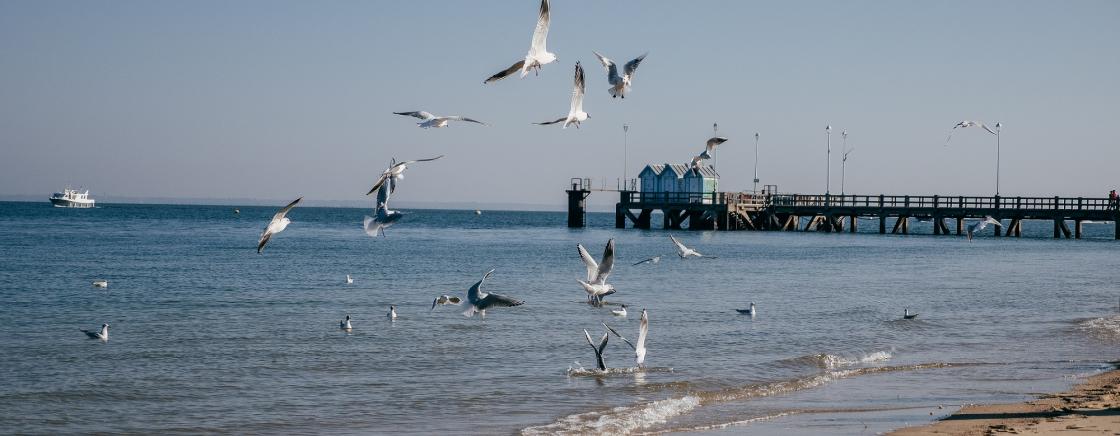
We are pleased to take you on an excursion off the coast of Arcachon, a moment suspended in time, where history and emotions merge.
The treasures of the Arcachon Bay
The Arcachon Bay, a true jewel of French heritage, offers a breathtaking landscape as far as the eye can see, overlooking the Atlantic Ocean.
In the 19th century, local economic life was dominated by fishing and shepherds. At that time, commercial life was still complicated, as it required a ten-hour drive to Bordeaux. It is only on 1941 that tourism was able to develop, thanks to the first railways at la Teste-de-Buch. This extended to Arcachon on 1857. It was only three years later that oyster farming developed in the Arcachon Bay. Today, the Bay has become one of the most visited sites in the region.
Arcachon attracted and welcomed more than 86,000 visitors in the summer of 2022. Indeed, there are many activities to do in Arcachon: climbing the top of the Dune du Pilat, visiting the Cap Ferret and its lighthouse, visiting the nature reserve of the Banc d’Arguin, lounging on the magnificent beaches of Arcachon and believe it or not, Arcachon has a city dedicated to every season, the City of Winter, the City of Summer, the City of Spring and the City of Autumn. Original, isn’t it?
This setting is a preserved environment thanks in particular to nature protection tools. Arcachon Bay is the 6th Marine Natural Park in France. This remarkable lagoon is in perpetual motion, both local residents and locals consider it a mosaic or mingle: the ocean, freshwater streams and sandbanks as far as the eye can see. It should be noted that some of the major tourist sites of the Bay are very well protected, such as the Pilat Dune, which is the largest in Europe with more than 60 million cubic metres of sand, stretching over 2. 7 km and almost 110 metres high. This immensity has allowed it to be classified as “Grand Site of France” since 1978. With its many tourist attractions and listed sites, the Arcachon Bay is full of treasures such as the Ile aux Oiseaux and the Domaine de Graveyron, two other listed sites.
The Ile aux Oiseaux, a wild universe: Half-land, half-water.
During the Middle Ages, the island broke away from a sandbank. It has become a fishing and hunting place for the inhabitants of the surrounding area. It was on 1925 that the State sold more than 44 hectares of this estate to a SCI. This territory has 11 huts that still exist today. It will take almost 80 years for the State to put back in management more than 219 hectares at the coastal conservatory. On more than half of this immense space, there are no fewer than 40 cabins, including the two most famous “Cabanes Tchanquées”. True emblem of Arcachon, these last ones charm many curious people every year.
Splendid wooden cabins erected in the middle of the Bay fleet, southeast of the Ile aux Oiseaux, proudly watch over Arcachon. These can be seen from their roof piles at low tide. Like old ladies, the huts are steeped in history and tradition.
Martin Pibert, a local oyster farmer, first came up with the idea of building a Cabane Tchanquée in 1883, in order to keep his oyster parks. It was destroyed on 1943 by a major storm. Today, however, we can still see its stilts when the tide is low. On 1945, a new hut was built by a carpenter from Arcachon. This cabin is brown with red shutters, it bears the number 51.
In 1948, a second hut was built a few dozen metres from the first one. This one is the number 53. The first hut is not the only the one to have experienced bad weather. Cabin number 53 was demolished due to severe storms. It was finally rebuilt in 2007 by the Teste-de-Buch Town Hall.
Besides, do you know where that strange name comes from: “tchanquées”? It is indeed a word from the Gascon “chancat” or “chancada”, meaning “fixed on stakes” or “mounted on stilts”. These two huts perched on their stilts thus bear their name very well.
Do these cabins make you dream? We have no doubt, come and discover them more precisely by walk at low tide or by water at high tide. To do this, several starting points are offered by different organizations, taking you on excursions.
In general, the Cabanes Tchanquées are mostly visited at high tide, as the sunlight reflecting on the colourful huts offers an exceptional spectacle. There are several types of boats available to get there: two flat-bottomed boats, about ten metres long, used in oyster farming: the Pinasse, the traditional boat of the Arcachon Bay and the Barge.
The two huts, however, are not open to visitors, but boats like to dock there whenever it is possible at high tide, to the delight of visitors, in order to climb the steps of these emblems of the Bay. The Cabanes Tchanquées, originally built to watch the oyster parks, are now inseparable from them.
Do the sea air and especially the call of Arcachon oysters make you hungry? Do not worry, it is quite obvious that the tasting of these, is part of the show. After a visit to the huts, the cultural immersion does not stop there, so you can enjoy good oysters, a local culinary speciality.
For this, head to the beach at Cap Ferret where oyster huts are a true religion. You will find the famous hut from the film "Les Petits Mouchoirs" or even directly at an oyster farmer. Producer Sylvie Latrille opens her doors to you, making you discover her world. From learning workshops to the opening of oysters, to the tasting, Madame Latrille from the hut c57 leaves nothing to chance.
Crédit photo : https://www.arcachon.com/tourisme/je-decouvre/les-incontournables-du-bassin/decouvrir-les-cabanes-tchanquees/